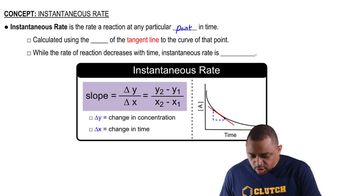Here are the essential concepts you must grasp in order to answer the question correctly.
Rate Law
The rate law of a reaction expresses the relationship between the rate of the reaction and the concentration of its reactants. For the given reaction, the rate law is Rate = k[A][B], indicating that the rate is directly proportional to the concentrations of both A and B. This means that if the concentration of either reactant changes, the rate of the reaction will change accordingly.
Recommended video:
Order of Reaction
The order of a reaction refers to the power to which the concentration of a reactant is raised in the rate law. In this case, the reaction is first order in both A and B, meaning that doubling the concentration of either reactant will double the rate of the reaction. Understanding the order helps predict how changes in concentration affect the reaction rate.
Recommended video:
Relative Rates
Relative rates compare the rates of reaction under different conditions, such as varying concentrations of reactants. By analyzing the concentrations of A and B in vessels (1)–(4), one can determine how the rate of reaction changes in each vessel. This concept is crucial for understanding how different setups influence the overall reaction speed.
Recommended video:




